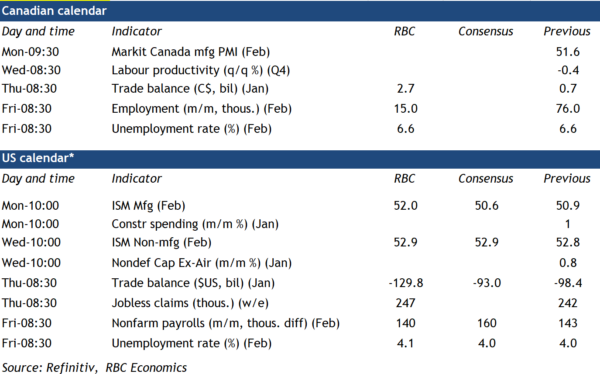The week ahead brings important labour market reports from both sides of the border. For Canada, it will be the final major data release before the Bank of Canada’s March 12 decision on interest rates.
We expect 15,000 jobs were added in February, a deceleration from January’s robust 76,000 gain. This modest growth should keep the unemployment rate steady at 6.6%, unchanged from January.
The Canadian labour market has shown improvement in early 2025 with January posting solid employment gains and a second consecutive monthly drop in the unemployment rate after hitting 6.9% in November.
But, while recent data have been more encouraging, the unemployment rate remains nearly 1 percentage point higher than a year ago. Uncertainty tied to potential U.S. tariffs rose significantly in late January and early February with both business and consumer confidence measures declining.
Tariff uncertainty alone (without actual tariff hikes implemented) won’t be enough to fuel layoffs, but it could slow hiring. Job postings on indeed.com edged lower in February after rising in December and January. And, not all estimates of recent job growth in Canada have been as strong as the labour force survey numbers. Separately reported job counts from Canada’s Survey of Employment, Payrolls and Hours have been lower in recent months, including an outright decline (-5,000) in December, excluding a bounce-back in the transportation sector tied to the end of the Canada Post strike.
In U.S., however, labour market conditions are firmer. For February, payroll employment likely rose by 140,000, little changed from last month. We expect the unemployment rate to drift higher from 4% to 4.1%. The U.S. labour market remains strong with February’s forecast. Robust consumer spending also continued to support growth. We continue to expect the U.S. Federal Reserve will keep rates unchanged at 4.25% to 4.5% throughout 2025.
Week ahead data watch
We expect the Canadian trade balance to widen again in January with exports that grew 2% and imports declining 0.8%. Oil prices were up almost 8% during the month, pushing the energy trade balance higher.
U.S. trade deficits likely widened in January, to $129.8 billion. According to the advance economic indicators report, the goods deficits grew by $31.2 billion month-over-month, driven by higher imports (+11.9%) that significantly outpaced the 2% growth in exports.













